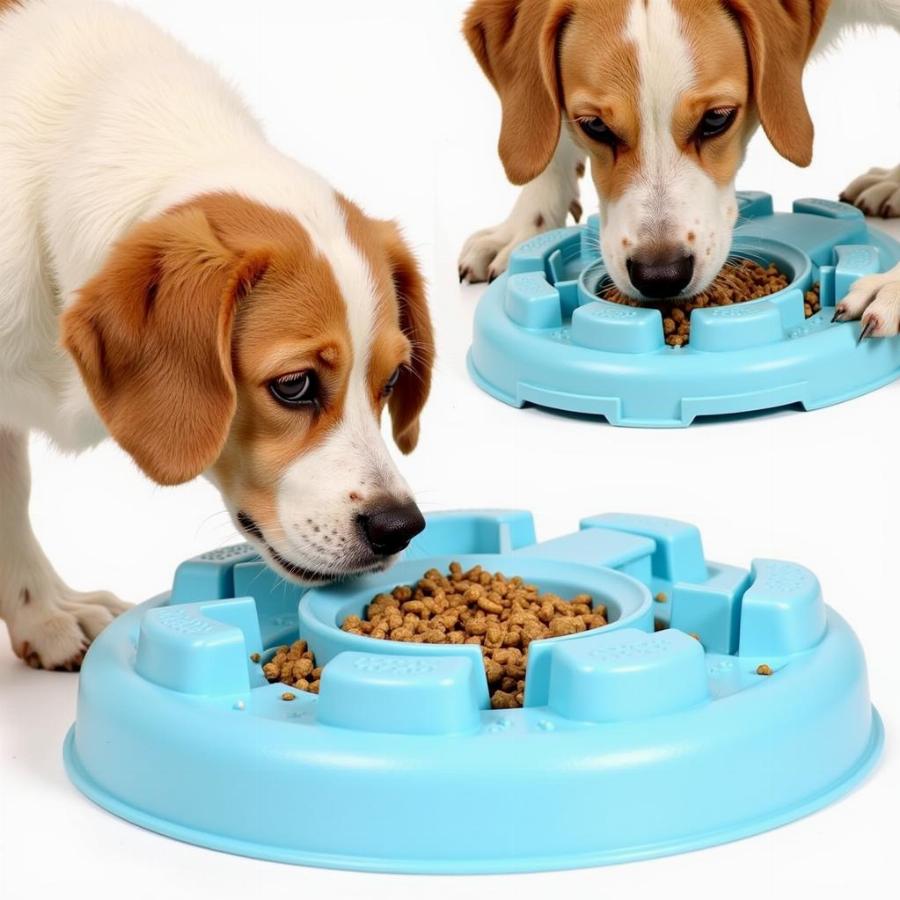A dog food dish might seem like a simple purchase, but it’s more than just a bowl. The right dog food dish can contribute to your furry friend’s comfort, health, and overall well-being. From material and size to design and special features, choosing the right dog food dish for your pet requires careful consideration. This comprehensive guide will walk you through everything you need to know about selecting the ideal dog food dish.
Material Matters: What Your Dog’s Dish is Made Of
Dog food dishes come in a variety of materials, each with its own pros and cons. Stainless steel is a popular choice due to its durability, ease of cleaning, and resistance to bacteria. Ceramic dishes are another great option, often featuring attractive designs and being dishwasher-safe. Plastic dog food dishes are lightweight and inexpensive, but can be easily chewed or scratched, potentially harboring bacteria.
Sizing Up Your Dog’s Dinnerware: Choosing the Right Size
The size of your dog food dish should correspond to the size of your dog and their portion sizes. A small dish for a large dog will lead to frequent refills and potential messes, while a large dish for a small dog can be intimidating and wasteful. Consider your dog’s breed, age, and eating habits when choosing the appropriate size.
Elevated Elegance: The Benefits of Raised Dog Food Dishes
Elevated dog food dishes, also known as raised feeders, can be particularly beneficial for senior dogs or dogs with arthritis, neck pain, or other mobility issues. By raising the food bowl to a comfortable height, these dishes reduce strain on the dog’s neck and back, making mealtimes easier and more enjoyable.
Slow Down You Chow Hound: Slow Feeder Dog Food Dishes
If your dog tends to gulp down their food in record time, a slow feeder dog food dish can be a game-changer. These dishes feature various obstacles and ridges that force dogs to eat more slowly, promoting better digestion and preventing choking or vomiting.
 Slow feeder dog food dish for fast eaters
Slow feeder dog food dish for fast eaters
Which Dog Food Dish Material is Best?
Stainless steel, ceramic, and plastic each offer unique benefits. So, which one reigns supreme? While stainless steel’s durability and ease of cleaning make it a top contender, ceramic’s aesthetic appeal and dishwasher-safe convenience can’t be ignored. Plastic’s affordability is tempting, but its susceptibility to damage and potential bacterial growth should be carefully considered. Ultimately, the best dog food dish material depends on your individual dog’s needs and your personal preferences. dog food and water dish
Can My Dog Use a Human Bowl?
While technically your dog could use a human bowl, it isn’t always ideal. heavy dog bowls prevent spills and sliding, a common issue with lighter human bowls. Specialized dog bowls also cater to specific needs, such as slow feeding or elevated eating, which most human bowls don’t offer.
Finding the Perfect Fit: Matching Your Dog’s Needs
“Choosing the right dog food dish is about more than just aesthetics,” says Dr. Emily Carter, a veterinary nutritionist. “It’s a key component of ensuring your dog’s comfort and health during mealtimes.” Consider your dog’s individual needs. Does your large breed dog require a dog dish food that can accommodate large portions? Does your senior dog benefit from an elevated dish? Observing your dog’s eating habits and consulting with your veterinarian can help you make the best choice.
Conclusion
Selecting the right dog food dish is a crucial part of responsible dog ownership. By considering factors such as material, size, design, and special features, you can ensure that mealtimes are comfortable, safe, and enjoyable for your furry companion. Investing in the right dog food dish is an investment in your pet’s health and happiness. dog puzzle toys for large dogs can also enhance your dog’s mealtime experience.
FAQ
-
How often should I clean my dog’s food dish? Daily washing is recommended to prevent bacterial growth.
-
Can I put my dog’s ceramic dish in the dishwasher? Many ceramic dishes are dishwasher-safe, but always check the manufacturer’s instructions.
-
What’s the best dog food dish for a puppy? Stainless steel or ceramic dishes are often recommended for puppies due to their durability and ease of cleaning.
-
Are elevated dog food dishes good for all dogs? While particularly beneficial for senior dogs and those with mobility issues, elevated dishes can be suitable for dogs of all ages and sizes.
-
How can I prevent my dog from tipping over their food dish? Choose a heavy, wide-based dish or consider a non-slip mat.
-
What if my dog has food allergies? Stainless steel dishes are a good choice for dogs with allergies, as they are non-porous and easy to clean thoroughly.
-
Are there dog food dishes designed for travel? Yes, collapsible and portable dog food dishes are available for travel and on-the-go feeding.
“The simple act of choosing the right dog food dish can significantly impact a dog’s overall dining experience,” adds Dr. Carter. “It’s a small change that can make a big difference.” can dogs have ricotta cheese is a common question among dog owners, showcasing the importance of understanding canine dietary needs.
Beaut Dogs is your one-stop resource for all things dog-related, offering reliable, helpful, and in-depth information about the canine world. Visit https://beautdogs.com today to explore the wonderful world of dogs and learn how to care for them best. When you need support, please contact Email: [email protected] to get detailed and accurate answers from Beaut Dogs.